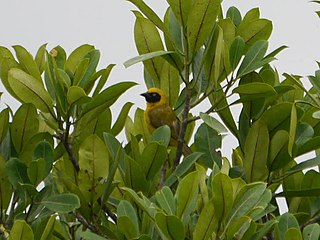
Bidens is a genus of flowering plants in the aster family, Asteraceae. The common names beggarticks, black jack, burr marigolds, cobbler's pegs, Spanish needles, stickseeds, tickseeds and tickseed sunflowers refer to the fruits of the plants, most of which are bristly and barbed, with two sharp pappi at the end. The generic name refers to the same character; Bidens comes from the Latin bis ("two") and dens ("tooth").

The conservation status of a group of organisms indicates whether the group still exists and how likely the group is to become extinct in the near future. Many factors are taken into account when assessing conservation status: not simply the number of individuals remaining, but the overall increase or decrease in the population over time, breeding success rates, and known threats. Various systems of conservation status exist and are in use at international, multi-country, national and local levels as well as for consumer use.

The greater round-eared bat is a bat species from South America. It is found in northeastern and southern Brazil, northern Argentina, Paraguay and Bolivia. The species feeds on fruit as well as hunting small birds. Once caught, birds are taken to a shelter and consumed.

The bidentate yellow-eared bat is a species of bat in the family Phyllostomidae, native to South America. Formerly classified in the Vampyressa genus, phylogenetic analyses support its inclusion in Vampyriscus.

Notiosorex cockrumi, also called Cockrum's gray shrew or Cockrum's desert shrew, is a tiny species of shrews named in 2003. This red-toothed shrew, which is as light as a penny, is the first new mammal species from Arizona since 1977. Its range extends from Arizona to central Sonora, Mexico.

A species that is extinct in the wild (EW) is one that has been categorized by the International Union for Conservation of Nature as known only by living members kept in captivity or as a naturalized population outside its historic range due to massive habitat loss.

Bidens campylotheca, the viper beggarticks, is a species of flowering plant in the family Asteraceae. It belongs to the genus Bidens, collectively called kokoʻolau or koʻokoʻolau in the Hawaiian language. It is found only in the Hawaiian Islands.

Bidens conjuncta, the bog beggarticks, is a species of flowering plant in the family Asteraceae. It belongs to the genus Bidens, collectively called kokoʻolau or koʻokoʻolau in the Hawaiian language. Bidens conjuncta is found only on western Maui.

Bidens cosmoides, commonly known as the cosmosflower beggarticks, is a species of flowering plant in the sunflower family. It is endemic to mixed mesic forests at elevations of 2,000–3,000 ft (610–910 m) on the island of Kauaʻi in Hawaii. This particular member of the genus Bidens is far larger than its relatives and is pollinated by birds.
Bidens mannii is a species of flowering plant in the family Asteraceae. It is endemic to Cameroon. Its natural habitat is subtropical or tropical high-altitude grassland. It is threatened by habitat loss.
Bidens molokaiensis, the Molokaʻi beggarticks, is a species of flowering plant in the family Asteraceae. It belongs to the genus Bidens, collectively called kokoʻolau or koʻokoʻolau in the Hawaiian language. It is found only on Molokaʻi in the Hawaiian Islands.
Bidens populifolia, the Oʻahu beggarticks or poplar-leaved bidens, is a species of flowering plant in the family Asteraceae. It belongs to the genus Bidens, collectively called kokoʻolau or koʻokoʻolau in the Hawaiian language. It is found only in the Koʻolau Range on Oʻahu.

Bidens wiebkei, the Molokaʻi koʻokoʻolau or Wiebke's beggarticks, is a species of flowering plant in the family Asteraceae. It belongs to the genus Bidens, collectively called kokoʻolau or koʻokoʻolau in the Hawaiian language. It is found only on Molokaʻi in the Hawaiian Islands. There are three occurrences of the plant remaining, for a total population of fewer than 1000.

Bannerman's weaver is a species of bird in the weaver family, Ploceidae. It is found in Cameroon and Nigeria. Its natural habitat is subtropical or tropical moist montane forests. It is threatened by habitat loss.

The Manado fruit bat is a species of megabat in the family Pteropodidae.

The lesser yellow-shouldered bat is a species of bat in the family Phyllostomidae. It is native to Peru and Ecuador. It is threatened by habitat loss.

Aglaia simplicifolia is a species of plant in the family Meliaceae. It is found in Brunei, India, Indonesia, Laos, Malaysia, and Thailand.
Recchia simplicifolia is a species of plant in the family Surianaceae.

Cordulephya bidens is a species of dragonfly in the family Cordulephyidae, known as the tropical shutwing. It inhabits rainforest streams in northern Queensland, Australia.














